|
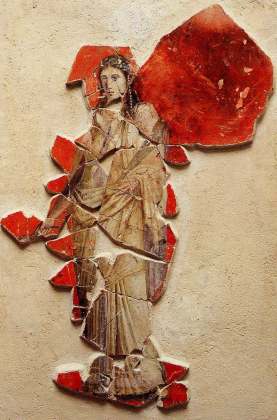 The
Magdalensberg (1058 m) represents the central elevation in a range of
hills between the Carinthian rivers Glan and Gurk. Today, its summit is
crowned by a church in late Gothic style, dedicated to Saint Helena and
Saint Magdalena. Abundance in water and fertile areas on the southern
slope as well as a site well suited for defence contributed to an early
and even dense settlement. The inhabitants of the town manufactured steel
and brass out of the metals of their country, such as iron, copper, and
zinc being blacksmiths and brassfounders. There may have been numerous
manufac-turing places of the kind all over the East Alps; this one, however
surpasses them in size as well as in commercial importance because of
its vicinity to Italy. As early as the beginning of he first century B.
C., an Italic trading colony developed in this place, firms from Rome
and Aquileia settling down in the Noric kingdom and in the territory of
the Norici. Advantage-ous trade became the pioneering force for politics,
preparing conditions for a peaceful occupation of the Noric country (15
B. C.). The town on the hill became a center of occupation; in addition
to the tradesmen, being those who really knew the country, there appeared
the representative of the Roman Empire whose duty it was to make provincials
out of the free Norici. This difficult task was mastered successfully;
not force or by precipitating matters, but patiently and during two generations,
until in 45 A. C. the province of Noricum and Virunum, the new capital
at the foot of the hill, could take up their respective functions. The
proceedings of the great power are clearly reflected in the buildings.
Where there had been the offices of the firms, the Empire built an official
quarter with considerable cost. The natural despression of the southern
slope was enlarged to a half circle by means of quarrywork, to the south,
earth was heaped up to form a large square surrounded by buildings on
four sides; to the west, a house of representation where the leaders of
the Noric tribes were summoned to assemblies; a seat of administration
and in the center a temple on a raised platform, imposing by its massive
masonry. This Roman quarter represents the most ancient large building
of the East Alps, and, at the same time, a place of peaceful politics
as it could not be easily encountered elsewhere. The
Magdalensberg (1058 m) represents the central elevation in a range of
hills between the Carinthian rivers Glan and Gurk. Today, its summit is
crowned by a church in late Gothic style, dedicated to Saint Helena and
Saint Magdalena. Abundance in water and fertile areas on the southern
slope as well as a site well suited for defence contributed to an early
and even dense settlement. The inhabitants of the town manufactured steel
and brass out of the metals of their country, such as iron, copper, and
zinc being blacksmiths and brassfounders. There may have been numerous
manufac-turing places of the kind all over the East Alps; this one, however
surpasses them in size as well as in commercial importance because of
its vicinity to Italy. As early as the beginning of he first century B.
C., an Italic trading colony developed in this place, firms from Rome
and Aquileia settling down in the Noric kingdom and in the territory of
the Norici. Advantage-ous trade became the pioneering force for politics,
preparing conditions for a peaceful occupation of the Noric country (15
B. C.). The town on the hill became a center of occupation; in addition
to the tradesmen, being those who really knew the country, there appeared
the representative of the Roman Empire whose duty it was to make provincials
out of the free Norici. This difficult task was mastered successfully;
not force or by precipitating matters, but patiently and during two generations,
until in 45 A. C. the province of Noricum and Virunum, the new capital
at the foot of the hill, could take up their respective functions. The
proceedings of the great power are clearly reflected in the buildings.
Where there had been the offices of the firms, the Empire built an official
quarter with considerable cost. The natural despression of the southern
slope was enlarged to a half circle by means of quarrywork, to the south,
earth was heaped up to form a large square surrounded by buildings on
four sides; to the west, a house of representation where the leaders of
the Noric tribes were summoned to assemblies; a seat of administration
and in the center a temple on a raised platform, imposing by its massive
masonry. This Roman quarter represents the most ancient large building
of the East Alps, and, at the same time, a place of peaceful politics
as it could not be easily encountered elsewhere.
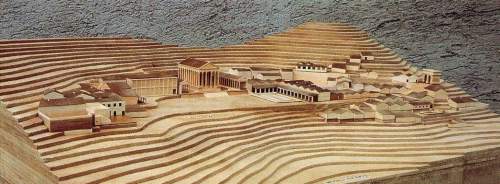
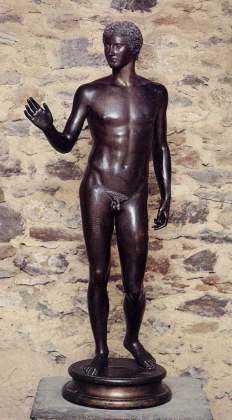 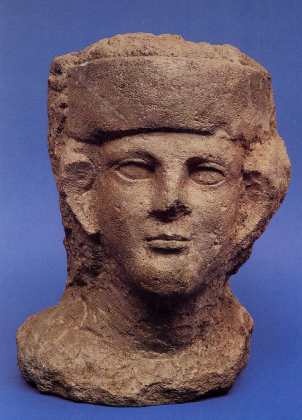 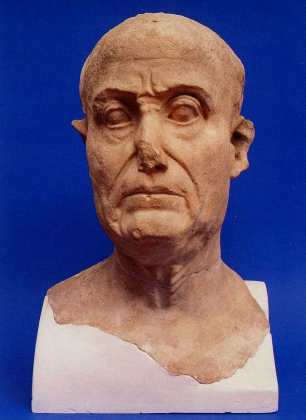
| Aus:
G. Piccottini/H. Vetters, Führer durch die Ausgrabungen auf dem Magdalensberg
5(Klagenfurt 1999) 149 |
|
|
 The
Magdalensberg (1058 m) represents the central elevation in a range of
hills between the Carinthian rivers Glan and Gurk. Today, its summit is
crowned by a church in late Gothic style, dedicated to Saint Helena and
Saint Magdalena. Abundance in water and fertile areas on the southern
slope as well as a site well suited for defence contributed to an early
and even dense settlement. The inhabitants of the town manufactured steel
and brass out of the metals of their country, such as iron, copper, and
zinc being blacksmiths and brassfounders. There may have been numerous
manufac-turing places of the kind all over the East Alps; this one, however
surpasses them in size as well as in commercial importance because of
its vicinity to Italy. As early as the beginning of he first century B.
C., an Italic trading colony developed in this place, firms from Rome
and Aquileia settling down in the Noric kingdom and in the territory of
the Norici. Advantage-ous trade became the pioneering force for politics,
preparing conditions for a peaceful occupation of the Noric country (15
B. C.). The town on the hill became a center of occupation; in addition
to the tradesmen, being those who really knew the country, there appeared
the representative of the Roman Empire whose duty it was to make provincials
out of the free Norici. This difficult task was mastered successfully;
not force or by precipitating matters, but patiently and during two generations,
until in 45 A. C. the province of Noricum and Virunum, the new capital
at the foot of the hill, could take up their respective functions. The
proceedings of the great power are clearly reflected in the buildings.
Where there had been the offices of the firms, the Empire built an official
quarter with considerable cost. The natural despression of the southern
slope was enlarged to a half circle by means of quarrywork, to the south,
earth was heaped up to form a large square surrounded by buildings on
four sides; to the west, a house of representation where the leaders of
the Noric tribes were summoned to assemblies; a seat of administration
and in the center a temple on a raised platform, imposing by its massive
masonry. This Roman quarter represents the most ancient large building
of the East Alps, and, at the same time, a place of peaceful politics
as it could not be easily encountered elsewhere.
The
Magdalensberg (1058 m) represents the central elevation in a range of
hills between the Carinthian rivers Glan and Gurk. Today, its summit is
crowned by a church in late Gothic style, dedicated to Saint Helena and
Saint Magdalena. Abundance in water and fertile areas on the southern
slope as well as a site well suited for defence contributed to an early
and even dense settlement. The inhabitants of the town manufactured steel
and brass out of the metals of their country, such as iron, copper, and
zinc being blacksmiths and brassfounders. There may have been numerous
manufac-turing places of the kind all over the East Alps; this one, however
surpasses them in size as well as in commercial importance because of
its vicinity to Italy. As early as the beginning of he first century B.
C., an Italic trading colony developed in this place, firms from Rome
and Aquileia settling down in the Noric kingdom and in the territory of
the Norici. Advantage-ous trade became the pioneering force for politics,
preparing conditions for a peaceful occupation of the Noric country (15
B. C.). The town on the hill became a center of occupation; in addition
to the tradesmen, being those who really knew the country, there appeared
the representative of the Roman Empire whose duty it was to make provincials
out of the free Norici. This difficult task was mastered successfully;
not force or by precipitating matters, but patiently and during two generations,
until in 45 A. C. the province of Noricum and Virunum, the new capital
at the foot of the hill, could take up their respective functions. The
proceedings of the great power are clearly reflected in the buildings.
Where there had been the offices of the firms, the Empire built an official
quarter with considerable cost. The natural despression of the southern
slope was enlarged to a half circle by means of quarrywork, to the south,
earth was heaped up to form a large square surrounded by buildings on
four sides; to the west, a house of representation where the leaders of
the Noric tribes were summoned to assemblies; a seat of administration
and in the center a temple on a raised platform, imposing by its massive
masonry. This Roman quarter represents the most ancient large building
of the East Alps, and, at the same time, a place of peaceful politics
as it could not be easily encountered elsewhere. 


